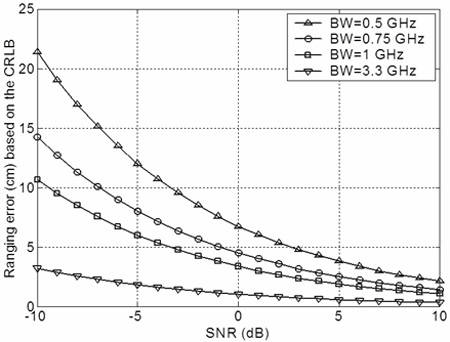Appendix10.A.Range Analysis of UWB Signals Using Time of Arrival
|
Appendix 10.A. Range Analysis of UWB Signals Using Time of ArrivalNathaniel J. August UWB can determine location by measuring the Time of Arrival (TOA) of signals [4]. Note that there are many other methods for determining range, such as time difference of arrival (TDOA), angle of arrival (AOA), and their combined radiolocation methods. The Cramer-Rao Lower Bound (CRLB) indicates the low bound on a TOA estimate as [6] Equation 10.A.1 where Figure 10.A.1 shows CRLBs on the ranging error in terms of SNR for four different UWB bandwidths: 0.5 GHz, 0.75 GHz, 1 GHz, and 3.3 GHz. The figure indicates that precise location information can be obtained even for UWB signals near a minimum bandwidth of 500 MHz and at moderate-to-low SNR values. Figure 10.A.1. Lower Bound of Ranging Errors.SOURCE: W. C. Chung and D. S. Ha, "An accurate ultra wideband (UWB) ranging for precision asset location," Proc. 2003 IEEE Conference on Ultra Wideband Systems and Technologies [4]). © IEEE, 2003. Used by permission. The basic process for ranging is as follows. First, the nodes synchronize to a reference clock. The reference clock may be a fixed universal reference like MSSI's PAL650 system [46], or the nodes may negotiate a local reference like Aether Wire's Localizers [50]. After synchronization, a TOA estimate for a received signal is obtained by detecting the peak of either (a) the original received signal or (b) the signal correlated with a template. A simple method of distance estimation is to multiply the time difference between two devices by the speed of light. However, due to noise and timing jitter, a single pulse may not provide an accurate estimation of distance. To overcome this error, one may estimate the average TOA of a train of pulses instead of a single pulse [4]. The time average of the received pulses reduces AWGN to enhance the accuracy. The use of multiple pulses increases the processing time, but the overall time required may still be a fraction of second. |
|
EAN: 2147483647
Pages: 110
